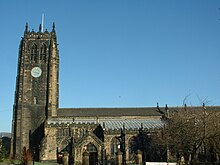Halifax Parish Church
| Halifax Minster | |
|---|---|
| Minster and Parish Church of St John the Baptist | |
 |
|
| Coordinates: 53°43′24″N 1°51′13″W / 53.72320°N 1.85371°W | |
| Country | United Kingdom |
| Denomination | Church of England |
| Churchmanship | Broad Church |
| Website | www.halifaxminster.org.uk |
| History | |
| Dedication | St. John the Baptist |
| Architecture | |
| Heritage designation | Grade I listed building |
| Architectural type | Perpendicular Gothic |
| Administration | |
| Parish | Halifax |
| Deanery | Halifax |
| Archdeaconry | Halifax |
| Episcopal area | Huddersfield |
| Diocese | Leeds |
| Province | York |
| Clergy | |
| Vicar(s) | Hilary Barber |
| Honorary priest(s) | Peter Baldwin |
| Asst Curate(s) | Matthew Hunter Jonathan Bish |
| Chaplain(s) | Martin Ashworth Frank Carless |
| Laity | |
| Reader(s) | Trish Boyd |
| Director of music | Chris Brown |
| Organist(s) | Graham Gribbin Philip Tordoff |
| Organ scholar | Jonathan Clegg |
| Churchwarden(s) | John Hardy Sheila Stoppard |
| Flower guild | Margaret Stears |
| Parish administrator | Gillian Farr |
| Servers' guild | Sheila Stoppard |
Halifax Minster in Halifax, West Yorkshire, England, is dedicated to St John the Baptist; three West Yorkshire minsters are at Dewsbury (1993), Halifax (2009) and Leeds (2012).
There has certainly been a church at Halifax for about 900 years. The Minster, formerly a Parish Church until 23 November 2009, was completed by about 1438. It comprises a nave, chancel and full-length aisles, and is thought to be the third church on this site, but it includes stonework from earlier periods. There are a few carved chevron stones, which date from before 1150, and several 12th century tomb-covers in the porch. Windows of the Early English style in the north wall are replacements of originals dating from the 14th century. A portion of this north wall is much earlier, and may have originally been part of the Norman church; it has sometimes been claimed this was the south wall of an older church.
After the completion of the present nave and chancel, several additions were made. The tower was erected between 1449 and 1482; and the Rokeby and Holdsworth Chapels - originally chantry chapels - were completed by about 1535.
Jacobean box pews are a prominent feature of the Minster, and most of those in the nave date from 1633 to 1635. They bear some similarity to those at Bolton Percy, and the names of the carpenters involved are known. A pew in the centre aisle bears the remains of a memorial brass to John Waterhouse, who died in 1539/40. The carved arms of Richard Sunderland of High Sunderland, who died in 1634, are attached to another pew. Several ancient pew nameplates may be seen attached to a board on the inner north wall of the tower, the oldest dates to 1615 and reads “This stall made at the cost of Robert Fisher of Halifax.”
A small portion of Medieval stained-glass survives in the upper westernmost clerestory window, which was removed from other windows in the mid 19th century. The Puritans who were prominent in the town in the 17th century, thought stained glass with its ‘images’ was an abomination. During the Commonwealth (1649–1660) many plain-glass leaded windows of a unique design were installed, paid for by Mrs Dorothy Waterhouse. Many of these were later replaced by Victorian stained glass, but those that survived in 1958 were carefully rebuilt. At that date there were three of these on each side of the chancel, but now there are five on the south side and only one on the north. The large west window in the tower is a late 19th-century reconstruction of a Commonwealth window dating from 1657, but contains no original work. The great east window of the church depicts the Crucifixion and Resurrection of Jesus, and was completed in 1854. It is the work of George Hedgeland (1825–98), who exhibited stained glass at the Great Exhibition of 1851. The remaining glass in the Parish Church dates also from the Victorian and Edwardian periods.
...
Wikipedia
